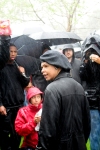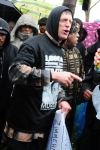March 25, 2012—South Los Angeles—In light of the recent, unjustifiable, cold-blooded killing of 17-year-old Trayvon Martin, by George Zimmerman, Occupy the Hood (Los Angeles) and community members gathered to march from Exposition Blvd. and Crenshaw Blvd. to Leimert Park to show support for Trayvon and to speak about the systematic injustices that occur on a daily basis due to racism.
A crowd of at least 100 gathered at the aforementioned cross street while harsh rain pounded down upon the earth, creating massive puddles and small waves of water to flow alongside curbs and in any crevice it could meander its way in to. One man, unphased by the weather, clinched in his hands a large bag of Skittles and a can of iced tea (the two items Trayvon had just purchased from the local 7-11 before returning to the gated community where he was staying). Some held black t-shirts wrapped in dry-cleaner plastic with the largely-known photo of Trayvon in a hoodie that read: “1,000,000 Hoodie March for Trayvon Martin.”
After trudging through the harsh weather Sunday had to offer, supporters gathered in Leimert Park to speak about the large issue of racism as a whole, how its injustices and oppression manifest itself into daily struggles and what can be done to combat the systematic brutality—in all forms—toward people of color.
The mainstream media was on hand to make sure to capture images of the crowd, but they were largely uninterested in the subject matter which was being discussed. All mainstream media cameras were gone within minutes after arriving to the park.
Please take the time to read this piece on racism by d.E. Rogers, entitled “Racism vs. African-Americans in America” (photos below)
“There is no question that America’s history has been plagued by racism. Slavery remains a dark stain on America’s history which many would rather forget. In fact, there are some who believe it is forgotten, and that racism is no longer a serious issue in today’s American culture.
It is certainly true that racism is not as serious a problem now as in the past. Up until the civil rights era there were many parts of the country in which the government openly supported racist laws. While government support of racist policy is (mostly) a thing of the past, there is still an undercurrent of racism in the culture of America today.
Racist Stereotypes Remain
Today there are few people in America who will openly confess to being racist, and those people and organizations which do, such as the remaining Ku Klux Klan, are usually viewed as social outcasts. However, there are still many stereotypes against African-Americans which influence American culture. Most of these stereotypes are about violence and sex. A study in Philadelphia, for example, found that African-Americans were overly represented as perpetrators of crimes in local news outlets when compared to the actual rates of crime in the city.
Sexual stereotypes are also common, and African-American men and women are often depicted as aggressively sexual. While this stereotype is sometimes twisted into a compliment, it results in severe consequences. African-American men are more likely to be assumed guilty of a sexual crime than men of any other race in America. African-American women are more likely to be involved in the sex industry, but are often paid far less than white women.
Racism in the Media
The study in Philadelphia isn’t the only example of racism in the media far from it, in fact. The Entman-Rojecki Index of Race in Media, one of the most comprehensive studies on the subject, has found significant differences between how African-American and white characters are portrayed in movies. Black women are around five times more likely to be depicted as violent in movies, for example.
Racism in news programs is even worse. The Entman-Rojecki Index has found that it is four times more likely that an African-American’s mug shot will be featured in a crime story than a white person’s mug shot. Stories about African-American suspects are also twice as likely to show the suspect restrained than stories about white suspects.
The Katrina disaster was one of the most obvious examples of this bias in the last decade. The majority of the negative press coverage concerning looting and criminal behavior in post-Katrina New Orleans was focused on African-Americans. Some sarcastic commentators parodied the media coverage by observing that “Black people ‘loot’ food, but white people ‘find’ food.”
Economic and Social Differences
One of the most blatant examples of how racism remains in America today is the prison system. Approximately 10% of the male population of African-Americans between 25-29 are incarcerated at any one time, five times the rate of the next highest group. Racism also faces African-Americans who are looking for a job. While the national unemployment rate hovers around 10 percent, the unemployment rate for African-Americans is over 17 percent.
This isn’t merely a problem which is hurting urban or poor African-Americans, either. Middle-class African-Americans in cities across the country also find themselves suffering the same plight. Columnist Bob Herbert recently wrote about the problems facing African-Americans in Memphis, where he found that the “median income of black homeowners in Memphis has dropped to a level below that of 1990.” African-American families across the nation are more likely to be left unemployed no matter their income. The only thing more shocking than this is the relative lack of coverage in the press – while papers will happily report the statistics, few media outlets are willing to investigate the possibility that this difference is caused by racism.
Police Treatment and Racial Profiling
Racial profiling is one of the remaining examples of how racism still exists in the government. Simply being an African-American greatly increases your chances of being pulled over by police. One study in Maryland found that 76 percent of motorists stopped on a stretch of highway were African-Americans, while African-Americans only held 20 percent of all drivers licenses in the state.
Of all the topics surrounding racism in America today, racial profiling is by far the most hotly debated. The racial profiling debate moves forward on a daily basis, and while the debate mostly focuses on law enforcement, racial profiling is also a problem among the general public. No recent case illustrates this better than the arrest of Neli, an African-American teenager with Asperger’s. Neli was sitting outside of a school library when someone called the police stating that there was a black male with a gun. As it turned out, there was no gun, or any object like a gun – but by then Neli had been confronted by police. Many journalists and civil rights activists have rightly pounced on this case as an example of racial profiling, arguing that there was nothing different about Neli that would have made him stand out from anyone else in the area that morning – except for the fact that he is an African-American male.
Light Skin and Dark Skin Racism
One of the more subtle issues surrounding racism in America is the difference in racism against African-Americans based on the shade of their skin.
Multiple studies have found that racism against African-Americans is more severe for those who have darker shades of skin than those who have lighter shades of skin. One grim Stanford University study found that in death row cases an African-American defendant was twice as likely to receive the death penalty if he had very dark skin and traditionally African features when compared with African-Americans with lighter skin and more European features.
Similar findings have been discovered in regards to employment. A Bucknell University study found that African-Americans with light skin were more likely to obtain a job than African-Americans of dark skin, although both were less likely to receive a job than a white candidate.
In Conclusion
The unfortunate truth is that racism still exists in American culture. Many Americans of all races would rather not admit that this is the case. As a country we like to believe that we are civilized, and that we no longer let petty concerns such as race influence our views.
The evidence, however, is irrefutable. African-Americans are more likely to be depicted as violent in the media, are more likely to be sent to prison, are more likely to be pulled over or investigated by police and more likely to be unemployed. While America has made progress from the days when African-Americans were enslaved or blatantly persecuted by the government, our country still has a long ways to go.”










































